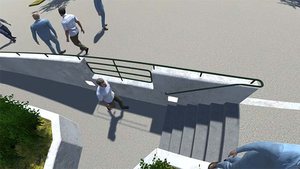Information
- Publication Type: Bachelor Thesis
- Workgroup(s)/Project(s):
- Date: October 2019
- Date (Start): March 2019
- Date (End): 10. October 2019
- Matrikelnummer: 01633402
- First Supervisor: Michael Wimmer
- Keywords: neural networks
Abstract
As the demand for ever-more capable computer vision systems has been increasing in recent years, there is a growing need for labeled ground-truth data for such systems. These ground-truth datasets are used for the training and evaluation of computer vision algorithms and are usually created by manually annotating images or image sequences with semantic labels. Synthetic video generation provides an alternative approach to the problem of generating labels. Here, the label data and the image sequences can be created simultaneously by utilizing a 3D render engine. Many of the existing frameworks for generating such synthetic datasets focus the context of autonomous driving, where vast amounts of labeled input data are needed. In this thesis an implementation of a synthetic data generation framework for evaluating tracking algorithms in the context of video surveillance is presented. This framework uses a commercially available game engine as a renderer to generate synthetic video clips that depict different scenarios that can occur in a video surveillance setting. These scenarios include a multitude of interactions of different characters in a reconstructed environment. A collection of such synthetic clips is then compared to real videos by using it as an input for two different tracking algorithms. While producing synthetic ground-truth data in real time using a game engine is less work intensive than manual annotation, the results of the evaluation show that both tracking algorithms perform better on real data. This suggests that the synthetic data coming from the framework is limited in its suitability for evaluating tracking algorithms.Additional Files and Images
Weblinks
No further information available.BibTeX
@bachelorsthesis{ESCHNER-2019-GDT,
title = "Generating Synthetic Training Data for Video Surveillance
Applications",
author = "Johannes Eschner",
year = "2019",
abstract = "As the demand for ever-more capable computer vision systems
has been increasing in recent years, there is a growing need
for labeled ground-truth data for such systems. These
ground-truth datasets are used for the training and
evaluation of computer vision algorithms and are usually
created by manually annotating images or image sequences
with semantic labels. Synthetic video generation provides an
alternative approach to the problem of generating labels.
Here, the label data and the image sequences can be created
simultaneously by utilizing a 3D render engine. Many of the
existing frameworks for generating such synthetic datasets
focus the context of autonomous driving, where vast amounts
of labeled input data are needed. In this thesis an
implementation of a synthetic data generation framework for
evaluating tracking algorithms in the context of video
surveillance is presented. This framework uses a
commercially available game engine as a renderer to generate
synthetic video clips that depict different scenarios that
can occur in a video surveillance setting. These scenarios
include a multitude of interactions of different characters
in a reconstructed environment. A collection of such
synthetic clips is then compared to real videos by using it
as an input for two different tracking algorithms. While
producing synthetic ground-truth data in real time using a
game engine is less work intensive than manual annotation,
the results of the evaluation show that both tracking
algorithms perform better on real data. This suggests that
the synthetic data coming from the framework is limited in
its suitability for evaluating tracking algorithms.",
month = oct,
address = "Favoritenstrasse 9-11/E193-02, A-1040 Vienna, Austria",
school = "Research Unit of Computer Graphics, Institute of Visual
Computing and Human-Centered Technology, Faculty of
Informatics, TU Wien ",
keywords = "neural networks",
URL = "https://www.cg.tuwien.ac.at/research/publications/2019/ESCHNER-2019-GDT/",
}


 thesis
thesis
